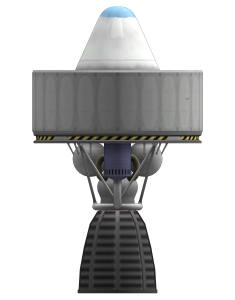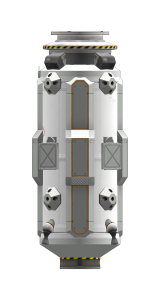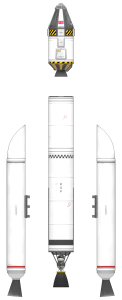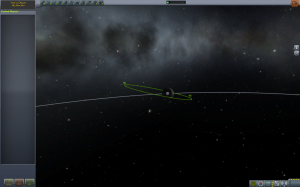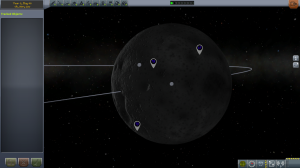We’ve spent a good deal of time exploring the local Kerbin system, so it’s time to get a bit further afield and visit some other planets. We’re going to start with Duna because it’s big and red, much like another planet that some fools in the real world have decided to go take a peak at.
Extra-planetary exploration is tough, especially with the lower technology level we have at the moment. One important thing is nuclear engines as they are hugely efficient and are pretty much the liquid fuel equivalent of ion engines. The TWR is poor, but in space that’s not a big issue.
I’m 100 science short of being able to afford nuclear technology, which is also the last node I can unlock without upgrading the R&D building. Fortunately there is a contract to return science data from around Minmus, and the Athena Survey Probe is still out there. Logging back into the probe, I collect the science form the ScanSat modules. This gives 91 science for the data and 116 science for completing the contract. That’s plenty to get Nuclear technology.
Windows:
Now transfer windows are important. You can’t just light the boosters and head off to Duna willy-nilly. If you do this sort of thing, you’re liable to drift in space for a very long time or end up at the wrong planet. Worse still you might end up on an impact trajectory with Jool – trust me, you don’t have enough delta-v to get out of that one if you leave it too late.
Transferring to the Mun and Minmus, we barely notice that we need a transfer window as one occurs very frequently and the distances really aren’t a problem as it only takes a couple of hours to arrive. Transferring to another planet is a different kettle of fish entirely. The transfer windows don’t come around very often, usually a couple of times a year and the transfer time can be well over a year to get to the outer planets.
The transfer window is the amount of time that you have to perform a burn to do a Hohmann Transfer so that you will enter the sphere of influence of the target body as it orbits around the star. You have to aim for where the target planet will be when you arrive. Depending on how much delta-v you have available you can take a more inefficient, but faster, route, but if time is not an issue then you are generally best advised to make the most efficient burn possible.
Porkchops:
The next thing to do, now we understand what a transfer to another planet involves, is to get the maths out and find out when we need to fire up the engines and for how long. We can do this the hard way, and use the angles between the planets and the manoeuvre nodes to slide things around to get an encounter. I prefer to do this a bit more scientifically, so we’re going to do it like NASA do it, with delicious pig products.
The actual mathematics of this is pretty hideous and involves some differential equations, which I don’t think anyone really enjoys. However, since it’s just a case of doing maths, computers are perfect for the application.
So after crunching the numbers you get this coloured plot. The blue areas denote the lowest delta-v usage and so the most efficient transfer while the red areas show the most inefficient transfers. When using MechJeb to perform this calculation it will allow you to set up the manoeuvre node automatically. Otherwise you’ll have to wait until the angles between the planets, relative to the sun, are as they should be and do the manoeuvre node yourself. In the porkchop plot shown the cross-hair shows the most efficient point and this translates into a delta-v requirement of nearly 1600m/s for the transfer and insertion burn.
It’s important to note here that the transfer will take 264 Kerbin days to complete and since these trajectories are very sensitive to initial conditions, going further means you have to be more accurate. Once most of the way to Duna we can perform some trim manoeuvres to fine tune everything.
Duna has an atmosphere that we can use for aero-braking, although we should have enough delta-v to not have to worry too much. When making the trip to Jool, you really need to aero-brake because you’re going far too fast to reasonably slow down with the engines.
Atlas I:
We’re not in a position to send Kerbals out to Duna just yet, mainly because building a multi section space ship really needs the 2.5m docking port. If you try it with 1.5m docking ports things like to flex and generally after “flex” comes “SNAP”. Snap is bad.
A new generation of multi-function, interplanetary probes are needed. The Atlas I carries a full orbital science package to collect data around Duna before sending one of its mini landers to the surface. This will de-orbit under it’s own power and enter the atmosphere before deploying a parachute to bring it gently down.
The Atlas I will then perform a transfer to Ike, Duna’s only moon. After another run of the scientific experiments from orbit, the second mini lander will decouple and head down to the surface. As there is no atmosphere to speak of on Ike, the probe will have to use its own engines to soft land. In the event that 1000m/s of delta-v is not sufficient to de-orbit and land gently, it will de-orbit and land hard. With no soft, fleshy Kerbals on board it’s no great loss, but it would be nice to get both bodies landed on with one mission.


The nuclear engines provide a total of 6.7km/s of delta-v, which is way more than we’ll probably need, but there’s no harm in being on the safe side for the first interplanetary launch. Is there? The downside is, as always, the weight with Atlas I weighing in at just over 22 tons for launch. Now it’s time for a delivery vehicle.

The whole thing isn’t cheap so I’ve got parachutes on the main booster and the SRBs to try and recover as much of the 155k this thing costs. None of the payload is planned to ever return to Kerbin, so everything attached to that has already been written off – the science it brings will be more than worth it.
Leaving for Duna:
Before setting off I take on the contracts to explore Duna and Ike. These give a pretty nice up front payment and will total over 500k funds when completed and since we’e planned a mission to Duna, we might as well get paid for it.
The launcher is pretty serious and takes Atlas I to an apoapsis of 500km immediately after launch. The orbital stage decouples just before apoapsis and then pushes the Atlas I into it’s final orbit to prepare for the transfer to Duna.
Now it’s just a case of unpacking the payload by removing the fairings and then decoupling the nuclear engines from their mountings. To make things slower and a little safer, this is done in one stage, before a separate staging command blasts off the nuclear engine fairings and makes them ready for use.
Once all the jettisoned stages have drifted away a little, it’s time to open up the three giant solar arrays that the ship will use to charge it’s batteries. This is, once again, likely to be overkill, but better safe than sorry in case something silly happens.
With Atlas I under it’s own power and in a stable orbit, it’s time to let MechJeb calculate the planetary transfer for me:

Here I’ve chosen a fairly aggressive burn to reduce the time to the arrival at Duna to the one shown above. Since I’ve got bucket loads of fuel we might as well get there a bit quicker, we also leave in 4 days, rather than in the 19 shown. It’s still 110 days to Duna, but I did have options including taking a year to arrive. MechJeb sets the manoeuvre node up so well that my trajectory will fly straight through the centre of Duna, so I tweak it a little to give a periapsis of about 600km.
During the burn I miss this by a very small margin and end up with a periapsis of over 1,000,000 metres. This nicely illustrates the dependence on initial conditions, with a very small change in my initial velocity, I’ve changed course by 1000km! This isn’t the end of the world though. Moving focus to Duna, I find that a circularisation burn will cost more delta-v than we have remaining. This also ins’t the end of the world…
Half way into the transfer to Duna, I set up another manoeuvre node, this time to bring the periapsis down in a more controlled manner but still done far enough out that to drop the periapsis to 80km only costs a few dozen m/s.
This slideshow requires JavaScript.
Debriefing:
So Atlas I is on the way to Duna, with everything working as planned. The total travel time to a Duna encounter is 110 days and we have an alarm set for 51 days in to perform the trim manoeuvre.
Once we get much closer to Duna I will perform another trim manoeuvre to bring Atlas I in for aero-capture. I wasn’t really planning on this and as a result the ship isn’t exactly designed with atmosphere in mind, hopefully everything will hold together and at least we won’t kill anyone.
What was it Jim Lovell said about problems…



























